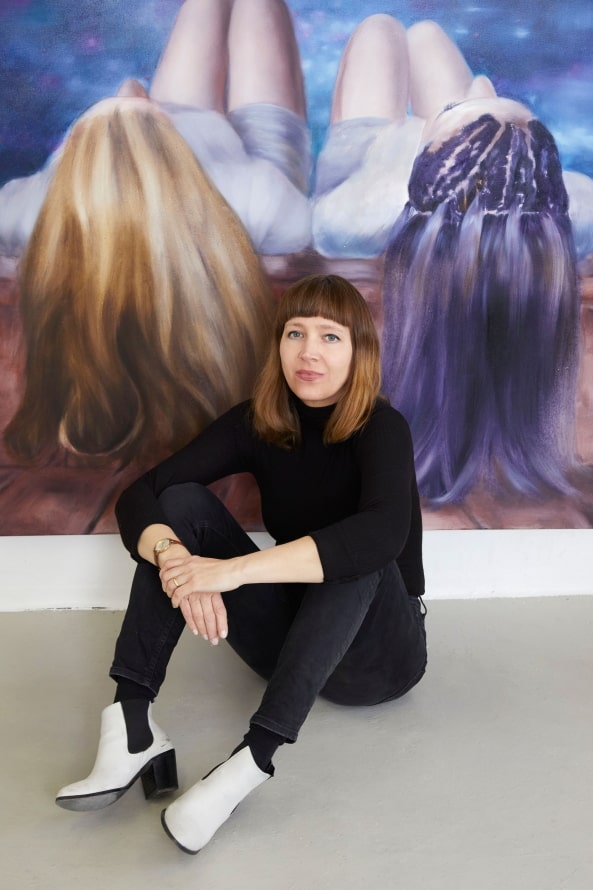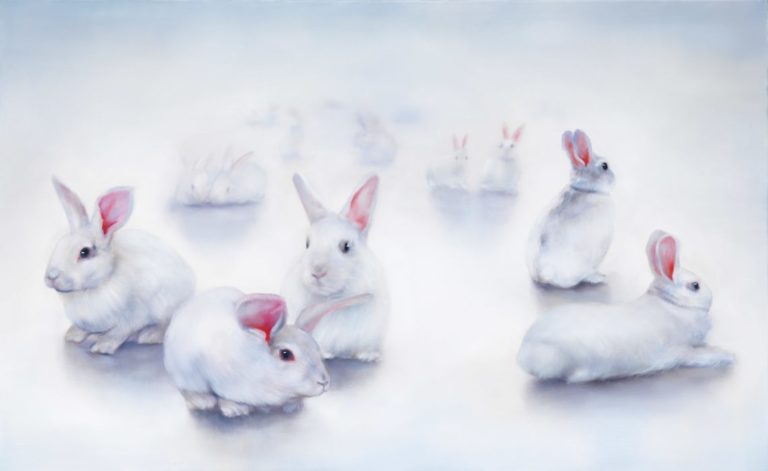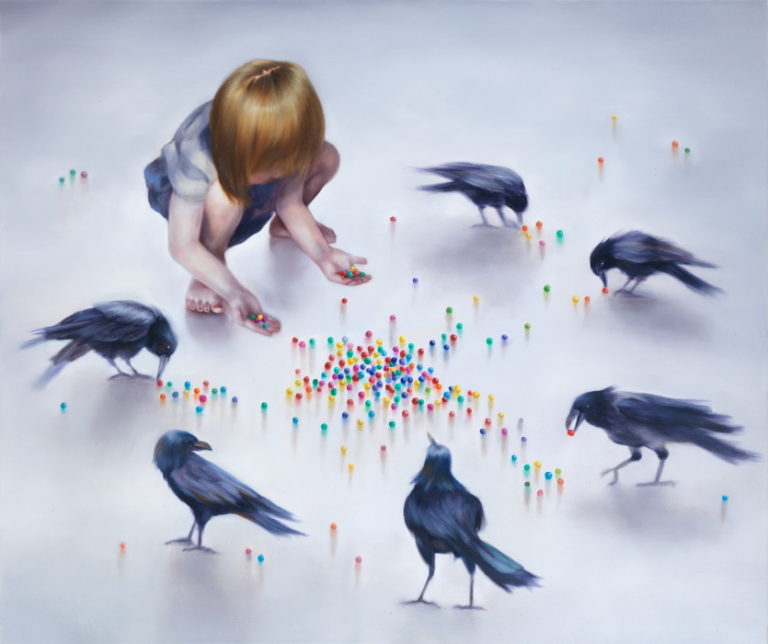Prologue | Personal –
Simone, imagine if the pandemic did not dominate our lives at the moment and we could meet in your home or in your studio. Where would we talk together? We meet in my studio in Berlin’s Pankow district; it’s on the top (6th upper) storey of a pre-fab high-rise on a traffic artery. The whole building houses studios; from the outside, it seems empty, but inside it is full of life. And currently, a lot of construction and renovation is going on – everything’s very chaotic, with tradesmen everywhere. The corridors still have the green-brown patterned wallpapers from communist East German times. But my studio is very well-lit and white, and it has a fantastic view … onto a car dealership, supermarkets, private garden plots, gray-blue office buildings, and a discount hotel.
Image above: Portrait Simone Haack, Photo Julia Grossi

Maybe we are sitting at your favorite place? Yes, on my white, patent leather couch. The shelf with my art books is behind us, and in front of us are the pictures I’m currently painting, beside each other on several canvases.

Where do you come from, where were you born when? I grew up in Gyhum, an old village with 400 residents between Bremen and Hamburg. The village has no hospital, so I was born in Rotenburg/Wümme in 1978. How and where do you currently live and work? We live in Berlin’s Kreuzberg district near Gleisdreieck Park. I do my artistic work in my studio in Pankow/Weißensee. Which stations and people have shaped you? Artistically, primarily the stages of my studies: Bremen, Auckland, New Zealand, and Paris. I studied with several quite disparate professors, in order to form my position from differing perspectives. The most important of them for me were Karin Kneffel, Katharina Grosse, and Pat Andrea, along with my fellow students, with whom I still maintain good contact. Aside from that, repeated travels and work residencies always left me with a powerful impression, for example a grant in Namibia and, in recent years, trips to Indonesia, where my husband has archaeological projects. But the northern German landscape of my childhood also etched itself deeply into my pictorial memory: moors, fields, woods, orchards, rivers, burial mounds.

Which writers do you currently find exciting and which books are on your bookshelf? At the moment, I like these contemporary authors: Christian Kracht, Karl Ove Knausgard, Sibylle Berg, Sonja Heiss, Joachim Meyerhoff, Michel Houellebecq, Judith Hermann, Heinz Strunk, Florian Illies, Alice Munro, and Lisa Eckhart. Otherwise, my shelf is filled mostly with art books. Recently I’ve developed a passion for old children’s books with illustrations from the turn of the 19th to the 20th century. Which books have influenced or shaped you? In my twenties, the novels and essays of the Existentialists and their sphere influenced me greatly, especially those of Jean-Paul Sartre, Simone de Beauvoir, and Albert Camus, as well as Paul Bowles, Georges Perec, Henry Miller, and Bataille. The writings of Freud, Jung, Fromm, and the Mitscherlichs. The diaries and letters of Anais Nin, Etty Hillesum, Sylvia Plath, Lou Andreas Salome, Max Frisch, Kafka, Rilke, Alfred Kubin, Gauguin, and van Gogh.

What are you currently reading and where do you keep the book? I’m engrossed with Karl Ove Knausgard’s series of autobiographical novels. At the moment, the last part of “Kämpfen” (Min Kemp, My Struggle) has been on my nightstand for a while now. What music do you listen to and when? At the moment, my favorite music is electronic, when I paint or drive. But I listen to other things, too, as long as it carries me along. Some of my evergreens, in no particular order: David Bowie, Stereolab, Goldfrapp, Brian Eno, Roxy Music, Air, Radiohead, John Maus, Iggy Pop, Scott Walker, Kraftwerk, Moderat, La Femme, Jacco Gardner, Divine Comedy, White Rose Transmission, NO MORE, Aphex Twin, Get Well Soon, Rufus Wainwright, Metronomy, Beachhouse, The Convent, Velvet Condom, Calexico, Tindersticks, Nouvelle Vague, piano music by Bach, Scarlatti, Ligeti, Schönberg, Messien, Satie, Michael Nyman, Philipp Glass, Hans Otte, and so forth.

WeIf you would cook something for us, what would it be? A northern Italian ribollita! What do you like to eat most? The cuisine in Italy, Southeast Asia, home cooking from here. And sweets. What do you think about breakfast? — A lot. I have to eat breakfast if I’m to function. During the week, rather plainly in my studio; on the weekend, appreciatively with my family. I like it hearty. What kind of sport or counterbalance to your work do you practice? Sport isn’t my thing. Film and music are very important to me. I used to play piano and keyboard, and now I would really like to learn to play the church organ! Aside from that, I’ve written a diary since I was a teenager; it accompanies me through all my ups and downs. Do you have special passions or hobbies for which you are burning, and if so, which ones? No. Making art, looking at it, and opening it up – my favorite activities – are my profession.

Interview | Artist + Position
To begin, please tell us your artistic vita in a few sentences.
Right after graduating high school in 1997, I started my studies in Fine Arts at the University of the Arts in Bremen, first in the class of Jürgen Waller, then with Katharina Grosse, and the longest time with Karin Kneffel, whose master student I later became. In the middle, I spent a year studying abroad in Auckland, New Zealand, and after finishing as a master student, I spent a year on a DAAD scholarship at the École des Beaux-Arts in Paris. Actually, I wanted to stay there, but then I returned to Germany for a year’s grant at the Künstlerstätte Stuhr-Heiligenrode near Bremen. After that, I moved to Berlin as a freelance artist, with exhibitions, stipends, and occasional teaching. I had my first gallery exhibition in 2006 in the Galerie Moderne in Silkeborg, Denmark.

Briefly explain your current project or the upcoming exhibition.
In my exhibition ARCHIPEL in the Galerie Köppe Contemporary, I’m showing my paintings and drawings from recent years. For me, ARCHIPEL describes a kind of counter-world that works with the means of realism, but it depicts a kind of parallel track, rather than reality. ARCHIPEL is a timeless place in Somewhere.

What are you most concerned about at the moment; what is on your mind?
If I leave the pandemic aside, I’m very concerned with the role and position of women in society. In this country, but especially in patriarchic countries.
How did you come to art? Why art?
As a teenager, I first ran into the artists of Surrealism and Expressionism, which greatly motivated me to paint, myself. The possibility of developing, through and with painting, a pictorial language that goes far beyond what is visible and in which everything is possible – this fascinated me. From the beginning, I had the vision of an imagery with my own pictorial personnel and spaces and its own logic.

What makes you happy at the moment?
To be in my studio and have enough time to work. Especially on completely new pictures.
What is currently scaring you?
The mutations, German bureaucracy, the economic consequences of the pandemic, the regressions in gender relations, m/f/d.

Do you believe that art has a social responsibility? And what do you think it can do?
Of course! Maybe relevance is a better word, responsibility sounds so obligatory, and art is not obligated to anything. Art is free, not moral, and its effects are often subtle and indirect. That’s why it’s difficult to point to a one-to-one effect.
What makes your art special? What is it about – what are the central themes of your work?
In my drawings and paintings, I explore the image of the human being and I illuminate, above all, the themes of identity and individuality. My aim thereby is not to depict concrete people – portraits in the strict sense – but the development of timeless, suggestive-fictional likenesses that show a person in his physical and psychological existence – what I’d call “fictional portraits”.
THE DEED | DAS WERK: Simone Haack
The painter Simone Haack, who lives and works in Berlin, talks about the central message of her artistic work during her interview.

Le Sommeil, 2021, 90 x 100 cm, Oil on Cotton, Photo Lea Gryze
What makes your art special? Please describe the core theme and the central themes of your work.
In my drawings and paintings, I explore the image of the human being and I illuminate, above all, the themes of identity and individuality. My aim thereby is not to depict concrete people – portraits in the strict sense – but the development of timeless, suggestive-fictional likenesses that show a person in his physical and psychological existence – what I’d call “fictional portraits”.

Cherry Blossom Girl, 2019, 90 x 165 cm, Oil on Cotton, Photo Lea Gryze
I’m fascinated by the human as a being, with and in his surroundings, with his instincts, needs, emotions, and relationships – in relation to himself, to his body, to nutrition, to space, to clothing, to his fellow human beings, and also to animals. The animalistic aspect in humans, and the human aspect in animals. My painting thereby uses the means of realism, without thereby depicting “reality”.

Liebesperlen, 2021, 120 x 140 cm, Oil on Cotton, Photo Lea Gryze
I give the uncanny as much scope as the absurd, irony, and humor, because ambivalence in the pictorial expression is important to me.
“In the realm of emotions, the real is indistinguishable from the imaginary.” Andre Gide

Konspirative Sitzung, 2021, 80 x 120 cm, Oil on Cotton, Photo Lea Gryze
Introduce us to the work that, in your view, exemplifies or best embodies the message of your work.
They can be explored as sensual experiences; viewers need no additional information. I don’t want to stipulate; I want to enable the greatest possible freedom in reception. I’ve already indicated above what’s important to me. My picture “Four” (2013, 170 x 120 cm, oil on linen) puts a lot of that in a nutshell.

Vier, 2013, 170 x 120 cm, Oil on Cotton, Photo Lea Gryze
What is the aim of your art, your work, what is it supposed to achieve in the viewer?
To touch in some way, to get in contact with the viewer.
Translation: Mitch Cohen
THE DEED | DAS WERK is a complementary and separately presented part of THE INTERVIEW IN|DEEDS with Simone Haack.
How do you protect yourself from too much inspiration these days?
I have nothing against too much inspiration, if I have my sketchbook and my camera with me to capture thoughts and ideas.

How much in your works is planned in advance – how much is created intuitively?
It’s an interplay between the two. In the beginning, I plan a lot; but during the painting process, I try to be open to the picture and to react to it. Sometimes I drift entirely away from the original idea.
What are your (next) goals?
At the moment, I am a guest artist in the solo exhibition of my cherished painter colleague Lubomir Typlt in the DSC Gallery in Prague (until April 10), and, starting on March 19, the Galerie Obrist in Essen is staging a three-part exhibition on the theme of “CLOSENESS”, with exciting artists like Eva & Adele, Twin Gabriel, and John Coplans, curated by Sabine Kampmann. A highly recommendable art book “Preparing for Darkness” by Uwe Goldenstein (Galerie Selected Artists) recently appeared; there will also be exhibitions curated by him. Starting in June, the Bomann Museum Celle will host a major exhibition “Wider das Böse”, curated by WP Fahrenberg, the group exhibition “Female Gaze” at the Alexander Ochs gallery, curated by Silke Tobeler, and later in the year, I’ll take part in the exhibition “The New Force of Painting” in the Frissiras Museum in Athens.

What is your opinion about faith? Do you have principles of faith or is there a motto?
I try to trust that everything in life has a meaning.
Which project would you still like to realize, if lack of time, courage or financial resources would not play a role?
To make a movie.
What do you consider to be attributes of good art?
It moves people, touches them, triggers things, attracts, lulls, carries you along, stirs up, confuses, enthuses, disturbs.
Is one born as an artist? Or is studying art compulsory in your view?
Both. Of course, being born as an artist sounds very theatrical, but ultimately either you have the tendency or you don’t. And you can train it at art school, but you don’t have to.
To whom do you show a new work first?
Usually my husband or colleagues.
What does the first hour of your day look like?
I sit in my car. My studio, our apartment, and our kindergarten are far apart in the city…

In times of the internet of things, are galleries still necessary? If so, why and what for?
Absolutely! As a physical site and label, indispensable. Good galleries place artists in the art world, and beyond that, they are mediators of culture. Offline and online.
Social media – in your view a blessing or a curse?
A blessing, especially in times of the lockdown and contact restrictions.
Translation: Mitch Cohen
Epilogue | Current
The solo show ARCHIPEL with new works by Simone Haack is visible from 30th March to 22nd May 2021 at the gallery Köppe Contemporary, Knausstraße 19, 14193 Berlin-Grunewald.
In times of Corona, when travel, studio visits and personal contacts are inappropriate or even impossible, the written interview remains an important medium to introduce artist personalities, to spread their messages and to stay in touch with art lovers. The interviews are not edited or shortened by the editors and are always reproduced in original sound. Therefore, we do not translate the interview into English or German, unless this is submitted by the interviewee.





